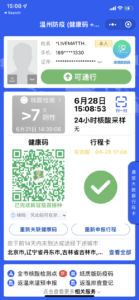After the last big UK lockdown of 2021, I scrambled to get out of the UK whilst I could. I decided to flee the country and arrive in China early before my contract with a Chinese university began: In case another lockdown took place, or even before travel restrictions worsened and delayed, or even completely scuppered my contract.
In July 2021, I finally flew from London Heathrow, one of the world’s busiest airports, of course, leaving a country that had seemingly moved on from COVID restrictions. This article doesn’t consider the author’s opinions on COVID and COVID restrictions, it purely conveys a first-hand experience of both the UK and China, back-to-back.
 Organising my flight to China was my introductory lesson into the workings of China’s zero-COVID policy. As virus variants emerged, China restricted flights from their hotspots and origins, with the UK falling under this remit as the Delta variant swept around the world. Direct flights were, therefore, unavailable, and one of the only routes into China for Travellers originating from the UK was from London Heathrow to Frankfurt, then to Nanjing.
Organising my flight to China was my introductory lesson into the workings of China’s zero-COVID policy. As virus variants emerged, China restricted flights from their hotspots and origins, with the UK falling under this remit as the Delta variant swept around the world. Direct flights were, therefore, unavailable, and one of the only routes into China for Travellers originating from the UK was from London Heathrow to Frankfurt, then to Nanjing.
Two days before flying, though, all travellers must have both a nucleic acid test and an IgM blood test at a Chinese government-approved testing organisation. Negative test data must then be shared with the Chinese government via a website, which then issues a green health code, valid for just 48 hours, that must be produced in order to be allowed to fly. Then, once again in Frankfurt, the same test, results and health code procedures must be undertaken for travellers to be allowed onwards to China.
On landing in China, the very first thing travellers are asked to do is to have a nucleic acid test administered, and then they are ushered onto coaches and taken to a pre-determined quarantine hotel where they must stay for 14-days before quarantining again under the supervision and testing of their local community.
What Zero COVID means

Day-to-day life in China leaves no room for COVID, and the local government reacts very rapidly to any reported cases. Cases are picked up on quickly, as testing is widespread. Staff members at medical facilities are widely tested twice weekly, and government and education staff receive regular tests.
Test data is fed through WeChat, China’s main social media app, and the app features a health code mini program, namely “Wenzhou (or relevant city name) Epidemic Prevention Code” (see right) that demonstrates the user’s health, and therefore, their freedom to access any place, from a university campus to a shop, a hotel to a restaurant. This health feature also conveys the user’s test time and results, their vaccination status, as well as an itinerary of where they have recently travelled. A current, local update is required to acquire a green health code certificate, allowing the holder into any restaurant, cafe, shopping centre and so forth.
As was the case in the spring of 2022, cases were on the rise in Shanghai. Despite the importance of Shanghai to China’s economy, the city of 26m people was put under strict lockdown for circa 2 months. Similar lockdowns threaten any city with ongoing positive COVID-19 cases.
Experience in Wenzhou

A tier 2 city, throughout the spring of 2022, Wenzhou periodically reported low numbers of COVID cases. In response, public events were cancelled. There were periods when classes at universities were rescheduled, and university campuses were cordoned-off for weeks and months at a time.
As part of my contract with a local university, as of June 2022, I am required every day to message my boss through WeChat, stating that I have not left the city.
Every Monday and Friday, I must take a screengrab of my travel itinerary (see left). This is part of the AliPay payment app which states where and when one has travelled. It also conveys your latest COVID-19 test status.
Also, every Tuesday, I must have a free-of-charge COVID-19 test at a testing station within the local university campus. To do so, I show them the screen of my “Wenzhou Epidemic Prevention Code” WeChat mini-program (top right). This is the aforementioned mini-program that enables one to board transport and enter eating, social, and retail establishments. The testing team scans the QR code on the screen, which identifies me, and then I receive my test. My test results, and COVID status show within my apps shortly after.












